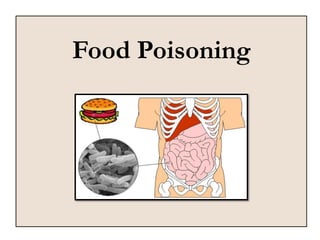
Microbiology food poisoning lecture
- 2. This Week’s Objectives: 1. Identify the most common causes for food poisoning 2. Identify and describe the most common bacteria involved in food poisoning 3. Discuss how bacteria causes food poisoning 4. Describe the ways to prevent food poisoning
- 3. What do you already know? The next few slides are designed to be a self-quiz. These questions in no way affect your grade; however will be useful for you to determine your current knowledge on this week’s lecture topic.
- 4. Question 1 Which of the following is a cause for food poisoning? Heating food above the specified cooking temperature Heating food at the specified cooking temperature Heating food below the specified cooking temperature A and C
- 5. Question 2 Which of the following is a bacteria that causes food poisoning? Aeromonas hydrophila Campylobacter jejuni Salmonella serotype Enteritidis All of the above
- 6. Question 3 Which of the following symptoms is associated with infection with C. jejuni ? Vomiting Skin rash Diarrhea All of the above
- 7. Question 4 Which of the following foods can cause food poisoning? Sprouts Beef Chicken None of the above
- 8. Why does food poisoning occur? • Mishandling of food- poor sanitation • Not cooking food thoroughly- poor preparation • Improper storage of food
- 9. Which bacterium are common in food poisoning cases? • Salmonella • E. Coli • Campylobacter • Listeria Salmonella E. coli Campylobacter Listeria
- 10. Example: Salmonella • Infection: Salmonellosis • Symptoms: fever, diarrhea, abdominal cramps • Number of cases per year: ~42,000 in the U.S. • Common serotypes: Typhimurium and Enteritidis • Common foods: eggs, beef, milk, pork, sprouts • Typical Cause: Raw/undercooked food item
- 11. What happens in your body? • You consume contaminated food • Bacteria passes through the stomach into the intestines • Attaches to intestinal wall and multiplies • Then either: • Stays attached • Travels to other body tissues • Produces a toxin that goes into your E. coli bloodstream • The route the bacteria takes correlates to the symptoms a person would have.
- 12. How do you prevent it?
- 13. What are the next steps for this week? • Complete the required reading • Check out the additional information/resources subpage • Complete the quiz (found in assignments subpage) • Read carefully this week’s main assignment (found in assignments subpage) • Complete group wiki assignment • Post any questions you may have in the help section!
Hinweis der Redaktion
- Picture used: http://www.ars.usda.gov/main/site_main.htm?modecode=53-25-23-00
- I hope you enjoyed the pre-lecture quiz. The rest of this lecture will cover the objectives described in the beginning of this presentation. Food poisoning occurs when a person consumes contaminated food. This food is contaminated by a bacteria or some other microorganism. A person may not have clean hands when handling food and thus bacteria is transferred from their hands to the food. Even if the food is cooked it could cause food poisoning. Another reason food poisoning can occur is if an item of food is not cooked properly, typically not cooked to the correct temperature. This is common when preparing beef and chicken. Lastly, food that is not stored as directed can cause bacteria growth and thus cause food poisoning. For example, an item of food that is supposed to be refrigerated, but instead is left out can cause food poisoning if consumed.Pictures used:Egg – http://www.emedicinehealth.com/slideshow_salmonella_outbreak/article_em.htmPoultry - http://www.realsimple.com/food-recipes/cooking-tips-techniques/preparation/food-safety-00100000062870/page4.htmlMeat - http://www.brazoshealth.org/EHS/FoodHand/goodfood.php
- The list provided is not an exhaustive list– that will be part of your assignment for this week! Also see the additional resources section.Pictures used:Salmonella - http://www.emedicinehealth.com/slideshow_salmonella_outbreak/article_em.htmE. coli – http://www.aolnews.com/2010/09/28/the-holy-six-strains-of-e-coli-that-many-experts-fear/Campylobacter- http://www.thehealthage.com/2012/05/garlic%E2%80%99s-ingredient-powerful-fighting-food-poisoning-antibiotics/campylobacter-infection/Listeria - http://www.cdc.gov/listeria/
- This slide provides an example of one bacterium that is common in food poisoning. This example is to aid in your assignment for this week. Please note that I expect that your wiki page is much more in-depth than the information provided here. This slide does not also cover all the information that is asked of you when doing your wiki.Information provided by:Centers for Disease Control and Prevention (CDC): http://www.cdc.gov/salmonella/
- The information provided here is common for most food poisoning cases. Information provided by:WebMD and CDC: http://www.webmd.com/food-recipes/food-poisoning/food-poisoning-and-safe-food-handling-what-happens and http://www.cdc.gov/salmonella/Picture: http://foodpoisoningsignsinfo.com/
- Fight Back Picture: http://blog.therapies4all.com/2011/12/how-to-prevent-food-poisoning.htmlSafe Internal Temperatures: http://www.cigna.com/individualandfamilies/health-and-well-being/hw/medical-topics/food-safety-te5036.html
- Have a great week!
